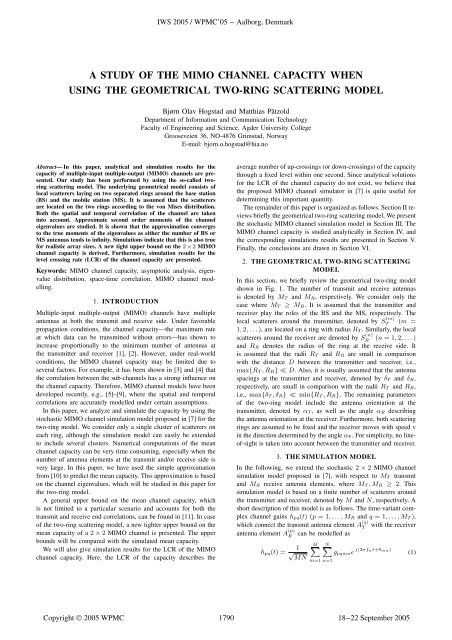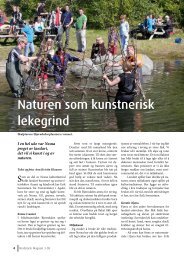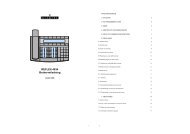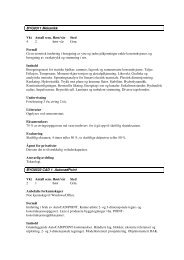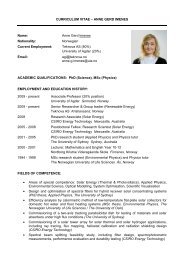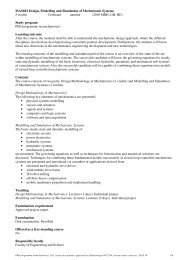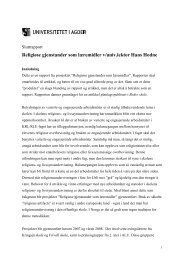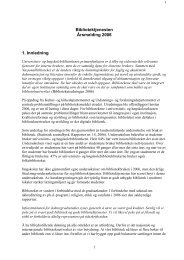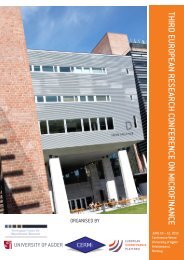A Study of the MIMO Channel Capacity When Using the Geometrical ...
A Study of the MIMO Channel Capacity When Using the Geometrical ...
A Study of the MIMO Channel Capacity When Using the Geometrical ...
Create successful ePaper yourself
Turn your PDF publications into a flip-book with our unique Google optimized e-Paper software.
A STUDY OF THE <strong>MIMO</strong> CHANNEL CAPACITY WHEN<br />
USING THE GEOMETRICAL TWO-RING SCATTERING MODEL<br />
Bjørn Olav Hogstad and Matthias Pätzold<br />
Department <strong>of</strong> Information and Communication Technology<br />
Faculty <strong>of</strong> Engineering and Science, Agder University College<br />
Grooseveien 36, NO-4876 Grimstad, Norway<br />
E-mail: bjorn.o.hogstad@hia.no<br />
Abstract— In this paper, analytical and simulation results for <strong>the</strong><br />
capacity <strong>of</strong> multiple-input multiple-output (<strong>MIMO</strong>) channels are presented.<br />
Our study has been performed by using <strong>the</strong> so-called tworing<br />
scattering model. The underlying geometrical model consists <strong>of</strong><br />
local scatterers laying on two separated rings around <strong>the</strong> base station<br />
(BS) and <strong>the</strong> mobile station (MS). It is assumed that <strong>the</strong> scatterers<br />
are located on <strong>the</strong> two rings according to <strong>the</strong> von Mises distribution.<br />
Both <strong>the</strong> spatial and temporal correlation <strong>of</strong> <strong>the</strong> channel are taken<br />
into account. Approximate second order moments <strong>of</strong> <strong>the</strong> channel<br />
eigenvalues are studied. It is shown that <strong>the</strong> approximation converges<br />
to <strong>the</strong> true moments <strong>of</strong> <strong>the</strong> eigenvalues as ei<strong>the</strong>r <strong>the</strong> number <strong>of</strong> BS or<br />
MS antennas tends to infinity. Simulations indicate that this is also true<br />
for realistic array sizes. A new tight upper bound on <strong>the</strong> 2 × 2 <strong>MIMO</strong><br />
channel capacity is derived. Fur<strong>the</strong>rmore, simulation results for <strong>the</strong><br />
level crossing rate (LCR) <strong>of</strong> <strong>the</strong> channel capacity are presented.<br />
Keywords: <strong>MIMO</strong> channel capacity, asymptotic analysis, eigenvalue<br />
distribution, space-time correlation, <strong>MIMO</strong> channel modelling.<br />
1. INTRODUCTION<br />
Multiple-input multiple-output (<strong>MIMO</strong>) channels have multiple<br />
antennas at both <strong>the</strong> transmit and receive side. Under favorable<br />
propagation conditions, <strong>the</strong> channel capacity—<strong>the</strong> maximum rate<br />
at which data can be transmitted without errors—has shown to<br />
increase proportionally to <strong>the</strong> minimum number <strong>of</strong> antennas at<br />
<strong>the</strong> transmitter and receiver [1], [2]. However, under real-world<br />
conditions, <strong>the</strong> <strong>MIMO</strong> channel capacity may be limited due to<br />
several factors. For example, it has been shown in [3] and [4] that<br />
<strong>the</strong> correlation between <strong>the</strong> sub-channels has a strong influence on<br />
<strong>the</strong> channel capacity. Therefore, <strong>MIMO</strong> channel models have been<br />
developed recently, e.g., [5]–[9], where <strong>the</strong> spatial and temporal<br />
correlations are accurately modelled under certain assumptions.<br />
In this paper, we analyze and simulate <strong>the</strong> capacity by using <strong>the</strong><br />
stochastic <strong>MIMO</strong> channel simulation model proposed in [7] for <strong>the</strong><br />
two-ring model. We consider only a single cluster <strong>of</strong> scatterers on<br />
each ring, although <strong>the</strong> simulation model can easily be extended<br />
to include several clusters. Numerical computations <strong>of</strong> <strong>the</strong> mean<br />
channel capacity can be very time consuming, especially when <strong>the</strong><br />
number <strong>of</strong> antenna elements at <strong>the</strong> transmit and/or receive side is<br />
very large. In this paper, we have used <strong>the</strong> simple approximation<br />
from [10] to predict <strong>the</strong> mean capacity. This approximation is based<br />
on <strong>the</strong> channel eigenvalues, which will be studied in this paper for<br />
<strong>the</strong> two-ring model.<br />
A general upper bound on <strong>the</strong> mean channel capacity, which<br />
is not limited to a particular scenario and accounts for both <strong>the</strong><br />
transmit and receive end correlations, can be found in [11]. In case<br />
<strong>of</strong> <strong>the</strong> two-ring scattering model, a new tighter upper bound on <strong>the</strong><br />
mean capacity <strong>of</strong> a 2 × 2 <strong>MIMO</strong> channel is presented. The upper<br />
bounds will be compared with <strong>the</strong> simulated mean capacity.<br />
We will also give simulation results for <strong>the</strong> LCR <strong>of</strong> <strong>the</strong> <strong>MIMO</strong><br />
channel capacity. Here, <strong>the</strong> LCR <strong>of</strong> <strong>the</strong> capacity describes <strong>the</strong><br />
average number <strong>of</strong> up-crossings (or down-crossings) <strong>of</strong> <strong>the</strong> capacity<br />
through a fixed level within one second. Since analytical solutions<br />
for <strong>the</strong> LCR <strong>of</strong> <strong>the</strong> channel capacity do not exist, we believe that<br />
<strong>the</strong> proposed <strong>MIMO</strong> channel simulator in [7] is quite useful for<br />
determining this important quantity.<br />
The remainder <strong>of</strong> this paper is organized as follows. Section II reviews<br />
briefly <strong>the</strong> geometrical two-ring scattering model. We present<br />
<strong>the</strong> stochastic <strong>MIMO</strong> channel simulation model in Section III. The<br />
<strong>MIMO</strong> channel capacity is studied analytically in Section IV, and<br />
<strong>the</strong> corresponding simulations results are presented in Section V.<br />
Finally, <strong>the</strong> conclusions are drawn in Section VI.<br />
2. THE GEOMETRICAL TWO-RING SCATTERING<br />
MODEL<br />
In this section, we briefly review <strong>the</strong> geometrical two-ring model<br />
shown in Fig. 1. The number <strong>of</strong> transmit and receive antennas<br />
is denoted by M T and M R, respectively. We consider only <strong>the</strong><br />
case where M T ≥ M R. It is assumed that <strong>the</strong> transmitter and<br />
receiver play <strong>the</strong> roles <strong>of</strong> <strong>the</strong> BS and <strong>the</strong> MS, respectively. The<br />
local scatterers around <strong>the</strong> transmitter, denoted by S (m)<br />
T<br />
(m =<br />
1, 2,...), are located on a ring with radius R T . Similarly, <strong>the</strong> local<br />
scatterers around <strong>the</strong> receiver are denoted by S (n)<br />
R<br />
(n =1, 2,...)<br />
and R R denotes <strong>the</strong> radius <strong>of</strong> <strong>the</strong> ring at <strong>the</strong> receive side. It<br />
is assumed that <strong>the</strong> radii R T and R R are small in comparison<br />
with <strong>the</strong> distance D between <strong>the</strong> transmitter and receiver, i.e.,<br />
max{R T ,R R}≪D. Also, it is usually assumed that <strong>the</strong> antenna<br />
spacings at <strong>the</strong> transmitter and receiver, denoted by δ T and δ R,<br />
respectively, are small in comparison with <strong>the</strong> radii R T and R R,<br />
i.e., max{δ T ,δ R}≪min{R T ,R R}. The remaining parameters<br />
<strong>of</strong> <strong>the</strong> two-ring model include <strong>the</strong> antenna orientation at <strong>the</strong><br />
transmitter, denoted by α T , as well as <strong>the</strong> angle α R describing<br />
<strong>the</strong> antenna orientation at <strong>the</strong> receiver. Fur<strong>the</strong>rmore, both scattering<br />
rings are assumed to be fixed and <strong>the</strong> receiver moves with speed v<br />
in <strong>the</strong> direction determined by <strong>the</strong> angle αv. For simplicity, no line<strong>of</strong>-sight<br />
is taken into account between <strong>the</strong> transmitter and receiver.<br />
3. THE SIMULATION MODEL<br />
In <strong>the</strong> following, we extend <strong>the</strong> stochastic 2 × 2 <strong>MIMO</strong> channel<br />
simulation model proposed in [7], with respect to M T transmit<br />
and M R receive antenna elements, where M T ,M R ≥ 2. This<br />
simulation model is based on a finite number <strong>of</strong> scatterers around<br />
<strong>the</strong> transmitter and receiver, denoted by M and N, respectively. A<br />
short description <strong>of</strong> this model is as follows. The time-variant complex<br />
channel gains h pq(t) (p =1,...,M R and q =1,...,M T ),<br />
which connect <strong>the</strong> transmit antenna element A (q)<br />
T<br />
with <strong>the</strong> receiver<br />
antenna element A (p)<br />
R<br />
can be modelled as<br />
h pq(t) =<br />
1<br />
√<br />
MN<br />
M<br />
N<br />
m=1 n=1<br />
g pqmne j(2πfnt+θmn) (1)
y<br />
A (1)<br />
T<br />
d 1m<br />
α T<br />
S (m)<br />
T<br />
d mn<br />
d n2<br />
S (n)<br />
R<br />
d n1<br />
φ (n)<br />
R<br />
αv A (1)<br />
R<br />
δ T<br />
φ (m)<br />
T<br />
α R<br />
0 T 0 R δ R<br />
d 2m<br />
A (M R )<br />
R<br />
A (M T )<br />
T<br />
R T D<br />
R R<br />
Fig. 1. <strong>Geometrical</strong> model (two-ring model) for an M T × M R channel<br />
with local scatterers around both <strong>the</strong> BS and MS.<br />
where<br />
g pqmn = a mq b np c mn (2)<br />
a mq = e j(M T −2q+1)π(δ T /λ) cos(φ (m)<br />
T −β T )<br />
(3)<br />
b np = e j(M R−2p+1)π(δ R /λ) cos(φ (n)<br />
R −β R)<br />
(4)<br />
c mn = e j 2π λ (R T cos φ (m)<br />
T<br />
−R R cos φ (n)<br />
R ) (5)<br />
f n = f max cos(φ (n)<br />
R<br />
− αv) . (6)<br />
The two sets {φ (m)<br />
T<br />
}M m=1 and {φ (n)<br />
R<br />
}N n=1 denote <strong>the</strong> angle <strong>of</strong> departure<br />
(AOD) and angle <strong>of</strong> arrival (AOA), respectively. Fur<strong>the</strong>rmore,<br />
<strong>the</strong> quantities f max and λ are denoting <strong>the</strong> maximum Doppler<br />
frequency and <strong>the</strong> wavelength, respectively. Finally, <strong>the</strong> phases<br />
θ mn are independent identically distributed random variables, each<br />
with a uniform distribution over (0, 2π]. Note that <strong>the</strong> complex<br />
channel gains h pq(t) are independent <strong>of</strong> <strong>the</strong> distance D between<br />
<strong>the</strong> transmitter and receiver.<br />
The space-time cross correlation function (CCF) <strong>of</strong> <strong>the</strong> stochastic<br />
simulation model can be expressed as [7]<br />
ρ(δ T ,δ R,τ)=ρ T (δ T ) · ρ R(δ R,τ). (7)<br />
In [7], ρ T (δ T ) and ρ R(δ R,τ) are <strong>the</strong> transmit and receive correlation<br />
functions, respectively, where <strong>the</strong> quantity τ denotes <strong>the</strong> time<br />
lag. For <strong>the</strong> intention <strong>of</strong> <strong>the</strong> paper, we need <strong>the</strong> elements R T ij <strong>of</strong><br />
<strong>the</strong> M T × M T transmit correlation matrix R T =[R T ij], which can<br />
be determined as follows<br />
R T ij =<br />
1<br />
= 1 M<br />
<br />
k=1<br />
M<br />
M R<br />
M R<br />
m=1<br />
E{h ki (t)h ∗ kj(t)}<br />
a m,2(j−i) (8)<br />
where i, j =1,...,M T . The operators E{·} and (·) ∗ denote <strong>the</strong><br />
expectation and <strong>the</strong> complex conjugation, respectively. Similarly,<br />
<strong>the</strong> elements R R ij <strong>of</strong> <strong>the</strong> M R×M R receive correlation matrix R R =<br />
[R R ij] can be expressed as<br />
R R ij =<br />
= 1 N<br />
1<br />
M<br />
T<br />
N<br />
M T<br />
k=1<br />
n=1<br />
E{h ik (t)h ∗ jk(t)}<br />
b n,2(j−i) (9)<br />
where i, j =1,...,M R.Accordingto[7]wehaveR11 T = ρ T (δ T )<br />
and R11<br />
R = ρ R(δ R, 0). It should be mentioned that separable<br />
transmit and receive antenna correlations where also used in [6],<br />
x<br />
[12], [13], and [14]. For <strong>the</strong> one-ring model, however, <strong>the</strong> spacetime<br />
CCF is non-separable [13, 3].<br />
For <strong>the</strong> space-time CCF given in (7), we need <strong>the</strong> distributions<br />
p(φ T ) and p(φ R) <strong>of</strong> <strong>the</strong> AOD and AOA, respectively. In many<br />
previous papers, such as [5], [15], and [6], <strong>the</strong> von Mises distribution<br />
has been proposed to describe <strong>the</strong>se distributions. The von<br />
Mises distribution function is given by<br />
1<br />
p(φ) =<br />
2πI 0(κ) eκ cos(φ−µ) , φ ∈ (0, 2π] (10)<br />
where I 0(·) is <strong>the</strong> zeroth-order modified Bessel function, and<br />
µ ∈ (0, 2π] accounts for <strong>the</strong> mean direction <strong>of</strong> <strong>the</strong> AOD/AOA.<br />
The quantity κ ≥ 0 is a control parameter for <strong>the</strong> spread <strong>of</strong> <strong>the</strong><br />
scatterers. We denote κ T and κ R as <strong>the</strong> degree <strong>of</strong> local scattering<br />
at <strong>the</strong> transmitter and receiver, respectively. Similarly, we define<br />
µ T and µ R as <strong>the</strong> mean AOD and <strong>the</strong> mean AOA, respectively.<br />
In case <strong>of</strong> isotropic scattering (κ T = κ R =0),wherep(φ T )=<br />
p(φ R)=1/(2π), <strong>the</strong>AOD{φ (m)<br />
T<br />
}M m=1 and <strong>the</strong> AOA {φ (n)<br />
R }N n=1<br />
<strong>of</strong> <strong>the</strong> simulation model determined by (1) can be computed by<br />
using <strong>the</strong> extended method <strong>of</strong> exact Doppler spread (MEDS) [7].<br />
On <strong>the</strong> o<strong>the</strong>r hand, if we consider non-isotropic scattering at<br />
ei<strong>the</strong>r <strong>the</strong> transmit or receive side, we recommend to compute <strong>the</strong><br />
parameters {φ (m)<br />
T<br />
}M m=1 or {φ (n)<br />
R<br />
}N n=1 according to a variant <strong>of</strong> <strong>the</strong><br />
L p-norm method described in [7].<br />
4. THE <strong>MIMO</strong> CHANNEL CAPACITY<br />
In this section, we study <strong>the</strong> information-<strong>the</strong>oretic channel capacity<br />
C(t), in bits/s/Hz, <strong>of</strong> <strong>the</strong> proposed stochastic simulation model. In<br />
<strong>the</strong> absence <strong>of</strong> channel knowledge at <strong>the</strong> transmitter, <strong>the</strong> channel<br />
capacity C(t) is defined as<br />
<br />
<br />
C(t) :=log 2<br />
det I MR + P T,total<br />
H(t)H H (t) (11)<br />
M T P N<br />
where det(·) denotes <strong>the</strong> determinant, I MR is <strong>the</strong> M R × M R<br />
identity matrix, P N represents <strong>the</strong> noise power, P T,total is <strong>the</strong> total<br />
transmitted power allocated uniformly to all M T antenna elements<br />
<strong>of</strong> <strong>the</strong> transmitter, H(t) =[h pq(t)] is <strong>the</strong> channel matrix, and (·) H<br />
denotes <strong>the</strong> complex conjugate transpose operator. We mention that<br />
<strong>the</strong> ratio P T,total /P N is called <strong>the</strong> signal-to-noise ratio (SNR).<br />
A. Approximate second order eigenvalue moments and <strong>the</strong> mean<br />
channel capacity<br />
The channel capacity can also be expressed in terms <strong>of</strong> <strong>the</strong><br />
eigenvalues λ i (i =1,...,M R) <strong>of</strong> H(t)H H (t) as (see [16])<br />
M<br />
R<br />
<br />
C(t) = log 2<br />
1+ P T,total<br />
λ i . (12)<br />
M T P N<br />
i=1<br />
If we focus on <strong>MIMO</strong> channels, where ei<strong>the</strong>r M T or M R is<br />
large, various simple approximate second order moments <strong>of</strong> <strong>the</strong><br />
eigenvalues can be found, e.g., in [10]. Without loss <strong>of</strong> generality,<br />
we need only consider <strong>the</strong> eigenvalues when M T is large, since <strong>the</strong><br />
resulting eigenvalues <strong>of</strong> H(t)H H (t) and H H (t)H(t) are identical.<br />
As M T →∞, it follows from [10] that <strong>the</strong> eigenvalues {λ i} M R<br />
i=1<br />
approach a normal distribution with mean<br />
E ∞{λ i} = M T λ R i . (13)<br />
In this equation E ∞{·} is <strong>the</strong> asymptotic expectation operator<br />
(for M T ≫ 1) and{λ R i } M R<br />
i=1 are <strong>the</strong> eigenvalues <strong>of</strong> <strong>the</strong> receive<br />
correlation matrix R R = [Rij], R where <strong>the</strong> elements Rij R are
determined by (9). Analogously, <strong>the</strong> variance <strong>of</strong> <strong>the</strong> eigenvalues<br />
λ i is given by (see [10])<br />
<br />
M T<br />
E ∞{(λ i − M T λ R i ) 2 } =(λ R i ) 2 (λ T k ) 2 (14)<br />
k=1<br />
where λ T k denotes <strong>the</strong> kth eigenvalue <strong>of</strong> <strong>the</strong> transmit correlation<br />
matrix R T =[Rij], T where <strong>the</strong> elements Rij T are determined by<br />
(8).<br />
<strong>Using</strong> <strong>the</strong> results in [10], where <strong>the</strong> logarithm function is<br />
approximated by a second order Taylor series expansion around<br />
<strong>the</strong> means <strong>of</strong> <strong>the</strong> eigenvalues {λ i} M R<br />
i=1 , and by taking (13) and (14)<br />
into account, <strong>the</strong> mean channel capacity can be approximated as<br />
E{C(t)} ≈<br />
M<br />
R<br />
i=1<br />
−<br />
{log 2<br />
1+ P T,total<br />
<br />
P N<br />
λ R i<br />
<br />
<br />
<br />
P T,total λ R 2 MT<br />
i<br />
M T (P N + P T,total λ R i ) (λ T k ) 2 }. (15)<br />
k=1<br />
This approximation is <strong>the</strong> so-called “asymptotic approximation”<br />
[10]. In <strong>the</strong> next subsection, we present a new tight upper bound<br />
on <strong>the</strong> <strong>MIMO</strong> channel capacity.<br />
B. Upper bounds on <strong>the</strong> <strong>MIMO</strong> channel capacity<br />
Jensen’s inequality [17] has been used in [11] to obtain an upper<br />
bound on <strong>the</strong> mean channel capacity for an arbitrary number <strong>of</strong><br />
antennas at <strong>the</strong> transmit and receive side. From [11], we have<br />
E{C(t)} ≤C T := log 2<br />
det I MT + P T,total<br />
ˆRT<br />
M T P<br />
<br />
N<br />
E{C(t)} ≤C R := log 2<br />
det I MR + P T,total<br />
ˆRR<br />
M T P N<br />
<br />
<br />
<br />
(16)<br />
(17)<br />
where ˆR T = M T R T and ˆR R = M RR R . Obviously, we obtain a<br />
tighter upper bound C bound by combining (16) and (17). Hence,<br />
C bound =min{C T ,C R}. (18)<br />
For <strong>the</strong> two-ring <strong>MIMO</strong> channel with M T = M R =2, we will<br />
present a new tight upper bound. The pro<strong>of</strong> is quite lengthly and<br />
will not be presented here for reason <strong>of</strong> brevity. The starting point<br />
is Jensen’s inequality and <strong>the</strong> concave nature <strong>of</strong> <strong>the</strong> logarithm<br />
function is exploited. An upper bound on <strong>the</strong> mean capacity can<br />
be derived after an interchange between <strong>the</strong> logarithm function<br />
and <strong>the</strong> expectation operator E{·}. Hence, after some algebraic<br />
manipulations, <strong>the</strong> new upper bound C up can be expressed as<br />
<br />
E{C(t)} ≤C up := log 2 { 1+ P 2<br />
T,total<br />
−<br />
·<br />
N<br />
N<br />
n=1 n ′ =1<br />
P N<br />
<br />
PT,total<br />
NP N<br />
2<br />
b n,2b n ′ ,−2}. (19)<br />
This bound is tighter than C bound given in (18), as we will see in<br />
<strong>the</strong> next section.<br />
A similar upper bound on <strong>the</strong> mean channel capacity when using<br />
<strong>the</strong> geometrical one-ring scattering model can be found in [18].<br />
5. SIMULATION RESULTS<br />
In <strong>the</strong> following, several simulation results for <strong>the</strong> <strong>MIMO</strong> channel<br />
capacity will be presented. Especially, <strong>the</strong> approximation <strong>of</strong> <strong>the</strong><br />
capacity by using <strong>the</strong> eigenvalues, <strong>the</strong> new upper bound C up, and<br />
<strong>the</strong> LCR <strong>of</strong> <strong>the</strong> channel capacity are presented. In all experiments,<br />
we have employed <strong>the</strong> simulation model defined by (1), where <strong>the</strong><br />
following parameters have been used. The radius <strong>of</strong> <strong>the</strong> ring around<br />
<strong>the</strong> transmitter and receiver is R T = R R =10m. The carrier<br />
wavelength λ is set to 0.15 m. The maximum Doppler frequency<br />
is 1 Hz, and <strong>the</strong> receiver is moving at an angle <strong>of</strong> αv = 0 ◦ .<br />
The antenna orientations are α T = α R =90 ◦ and <strong>the</strong> distances<br />
between <strong>the</strong> antenna elements are δ T = δ R = λ/2.<br />
Figure 2 compares <strong>the</strong> normal distribution with <strong>the</strong> means and<br />
<strong>the</strong> variances given by (13) and (14) with <strong>the</strong> eigenvalue distribution<br />
obtained through simulation. Here, M T =60and M R =3.<br />
We consider isotropic scattering around both <strong>the</strong> transmitter and<br />
receiver, where <strong>the</strong> numbers <strong>of</strong> scatterers are M = 120 and<br />
N = 48. From this figure, we see that <strong>the</strong> distribution <strong>of</strong> <strong>the</strong><br />
larger eigenvalues are well approximated. This is desirable, since<br />
<strong>the</strong> larger eigenvalues are generally more important than <strong>the</strong> smaller<br />
ones.<br />
The result shown in Fig. 3 are valid if <strong>the</strong> parameters <strong>of</strong> von<br />
Mises density (10) are set to κ T = κ R =10and µ T = µ R =0.<br />
From Figs. 2 and 3, we notice that <strong>the</strong> largest eigenvalue gives<br />
<strong>the</strong> best agreement between <strong>the</strong> distribution <strong>of</strong> <strong>the</strong> eigenvalue<br />
with that <strong>of</strong> <strong>the</strong> asymptotic value. This observation is confirmed<br />
in Figs. 4 and 5. In <strong>the</strong>se figures, we have plotted <strong>the</strong> quotient<br />
qmean<br />
i = E{λ i}/E ∞{λ i} between <strong>the</strong> simulated and <strong>the</strong><br />
asymptotic mean (solid line) and <strong>the</strong> quotient qvar<br />
i = E{(λ i −<br />
M T λ R i ) 2 }/E ∞{(λ i − M T λ R i ) 2 } between <strong>the</strong> simulated and <strong>the</strong><br />
asymptotic variance (dashed line) for i =1,...,M R,whereM R<br />
has been fixed to 3.<br />
The accuracy <strong>of</strong> <strong>the</strong> channel capacity approximation [see (15)]<br />
can be studied in Fig. 6. We notice that for a high SNR, <strong>the</strong> number<br />
<strong>of</strong> transmit antennas M T must be large for accurate prediction. This<br />
observation has also been made for a specified transmit and receive<br />
correlation matrix in [10].<br />
A comparison between <strong>the</strong> two upper bounds C bound and C up on<br />
<strong>the</strong> mean channel capacity for a 2×2 <strong>MIMO</strong> channel, is presented<br />
in Fig. 7. Although <strong>the</strong> new bound C up is tighter than C bound ,it<br />
is difficult to extend <strong>the</strong> proposed procedure to a higher number <strong>of</strong><br />
antenna elements.<br />
Finally, <strong>the</strong> normalized LCR N C(r)/f max <strong>of</strong> <strong>the</strong> channel capacity<br />
is illustrated in Figs. 8 and 9 for SNR= 10dB. These figures<br />
give insight into how <strong>of</strong>ten <strong>the</strong> capacity C(t) crosses a given level<br />
r within one second. Similar to <strong>the</strong> simulation results in [18], <strong>the</strong><br />
parameter κ R has a strong influence on <strong>the</strong> channel capacity. Figure<br />
8 illustrates that <strong>the</strong> change in <strong>the</strong> capacity is highest if we have<br />
isotropic scattering (κ R =0)around <strong>the</strong> receiver. Figure 9 shows<br />
that <strong>the</strong> parameter κ T has no influence on <strong>the</strong> normalized LCR.<br />
This result is not surprising, since we have fixed <strong>the</strong> position <strong>of</strong><br />
<strong>the</strong> transmitter.<br />
6. CONCLUSION<br />
In this paper, we have studied <strong>the</strong> <strong>MIMO</strong> channel capacity by<br />
using <strong>the</strong> geometrical two-ring scattering model. Both <strong>the</strong> spatial<br />
cross-correlations between <strong>the</strong> channel gains as well as <strong>the</strong> time<br />
correlation properties <strong>of</strong> <strong>the</strong> channel gains are taken into account.<br />
An approximation <strong>of</strong> <strong>the</strong> channel capacity by using <strong>the</strong> channel<br />
eigenvalues has been evaluated by means <strong>of</strong> simulation. For low<br />
SNRs, <strong>the</strong> approximation is quite accurate even for realistic antenna<br />
array sizes at both <strong>the</strong> transmitter and receiver. A new tight upper<br />
bound on <strong>the</strong> 2 × 2 <strong>MIMO</strong> channel capacity has been presented.<br />
Also, <strong>the</strong> LCR <strong>of</strong> <strong>the</strong> capacity has been studied by simulations.
REFERENCES<br />
[1] G. H. Foschini and M. J. Gans, “On limits <strong>of</strong> wireless communications<br />
in a fading environment when using multiple antennas,” Wireless Pers.<br />
Commun., vol. 6, pp. 311–335, 1998.<br />
[2] I. E. Telatar, “<strong>Capacity</strong> <strong>of</strong> multi-antenna Gaussian channels,” European<br />
Trans. Telecommun. Related Technol., vol. 10, pp. 585–595,<br />
1999.<br />
[3] D.-S. Shiu, G. J. Foschini, M. J. Gans, and J. M. Kahn, “Fading<br />
correlation and its effect on <strong>the</strong> capacity <strong>of</strong> mulitelement antenna<br />
systems,” IEEE Trans. Commun., vol. 48, pp. 502–513, Mar. 2000.<br />
[4] A. L. Moustakas, S. H. Simon, and A. M. Sengupta, “<strong>MIMO</strong><br />
capacity through correlated channels in <strong>the</strong> presence <strong>of</strong> correlated<br />
interferers and noise: a (not so) large n analysis,” IEEE Transactions<br />
on Information Theory, vol. 49, pp. 2545–2561, 2003.<br />
[5] A. Abdi, J. A. Barger, and M. Kaveh, “A parametric model for <strong>the</strong><br />
distribution <strong>of</strong> <strong>the</strong> angle <strong>of</strong> arrival and <strong>the</strong> associated correlation<br />
function and power spectrum at <strong>the</strong> mobile station,” IEEE Trans. Veh.<br />
Technol., vol. 51, pp. 425–434, May 2002.<br />
[6] G. J. Bayers and F. Takawira, “The influence <strong>of</strong> spatial and temporal<br />
correlation on <strong>the</strong> capacity <strong>of</strong> <strong>MIMO</strong> channels,” Wireless Communications<br />
and Networking, vol. 1, pp. 16–20, 2003.<br />
[7] M. Pätzold and B. O. Hogstad, “Design and performance <strong>of</strong> <strong>MIMO</strong><br />
channel simulators derived from <strong>the</strong> two-ring scattering model,” in<br />
14th IST Mobile & Wireless Communications Summit, Dresden,<br />
Germany, Jun. 2005, submitted and accepted for publication.<br />
[8] M. Pätzold, B. O. Hogstad, N. Youssef, and D. Kim, “A <strong>MIMO</strong><br />
mobile-to-mobile channel model: Part I – <strong>the</strong> reference model,”<br />
in Proc. 16th IEEE Int. Symp. on Personal, Indoor and Mobile<br />
Radio Communications, PIMRC 2005, Berlin, Germany, Sept. 2005.<br />
Submitted and accepted for publication.<br />
[9]B.O.Hogstad,M.Pätzold, N. Youssef, and D. Kim, “A <strong>MIMO</strong><br />
mobile-to-mobile channel model: Part II – <strong>the</strong> simulation model,”<br />
in Proc. 16th IEEE Int. Symp. on Personal, Indoor and Mobile<br />
Radio Communications, PIMRC 2005, Berlin, Germany, Sept. 2005.<br />
Submitted and accepted for publication.<br />
[10] C. Martin and B. Ottersten, “Analytic approximations <strong>of</strong> eigenvalue<br />
moments and mean channel capacity for <strong>MIMO</strong> channels,” in Proc.<br />
IEEE International Conference on Acoustics, Speech, and Signal<br />
Processing, (ICASSP ’02), vol. 3, pp. 2389–2392, May 2002.<br />
[11] S. Loyka and A. Kouki, “New compound upper bound on <strong>MIMO</strong><br />
channel capacity,” IEEE Communications Letters, vol. 6, no. 3,<br />
pp. 96–98, 2002.<br />
[12] D. Gesbert, H. Bölcskei, D. Gore, and A. Paulraj, “<strong>MIMO</strong> wireless<br />
channels: <strong>Capacity</strong> and performance prediction,” in Proc. IEEE<br />
Globecom ’00, vol. 2, pp. 1083–1088, San Fransisco, CA, Nov. 2000.<br />
[13] C. Martin and B. Ottersten, “Asymptotic eigenvalue distributions<br />
and capacity for <strong>MIMO</strong> channels under correlated fading,” IEEE<br />
Transactions on Wireless Communications, vol. 3, no. 4, pp. 1350–<br />
1359, 2004.<br />
[14] C. N. Chuah, D. Tse, J. Kahn, and R. Valenzuela, “<strong>Capacity</strong> scaling<br />
in <strong>MIMO</strong> wireless systems under correlated fading,” IEEE Trans.<br />
Inform. Theory, vol. 48, pp. 637–650, Mar. 2002.<br />
[15] M. Pätzold and B. O. Hogstad, “A space-time channel simulator for<br />
<strong>MIMO</strong> channels based on <strong>the</strong> geometrical one-ring scattering model,”<br />
in Wireless Commuinactions and Mobile Computing, Special Issue<br />
on Multiple-Input Multiple-Output (<strong>MIMO</strong>) Communications, vol.4,<br />
pp. 727–737, Nov. 2004.<br />
[16] A. Paulraj, R. Nabar, and D. Gore, Introduction to Space-Time<br />
Wireless Communications. Cambridge University Press, 2003.<br />
[17] T. Cover and J. Thomas, Elements <strong>of</strong> Information Theory. Wiley-<br />
Interscience, 1991.<br />
[18] B. O. Hogstad and M. Pätzold, “New tight upper bounds on<br />
<strong>the</strong> <strong>MIMO</strong> channel capacity,” in Proc. Nordic Radio Symposium<br />
(NRS) 2004 including <strong>the</strong> Finnish Wireless Communications Workshop<br />
(FWCW) 2004, Oulu, Finland, Aug. 2004.<br />
Probability Density<br />
0.1<br />
0.08<br />
0.06<br />
0.04<br />
0.02<br />
λ 1<br />
λ 2<br />
λ 3<br />
Asymptotic approximation<br />
Simulation<br />
0<br />
0 50 100 150<br />
Eigenvalues<br />
Fig. 2. The distribution <strong>of</strong> <strong>the</strong> eigenvalues {λ i } M R<br />
i=1 (M T =60, M R =3,<br />
and κ T = κ R =0).<br />
Probability Density<br />
0.25<br />
0.2<br />
0.15<br />
0.1<br />
0.05<br />
Asymptotic approximation<br />
Simulation<br />
λ 1<br />
λ 2<br />
λ 3<br />
0<br />
0 50 100 150<br />
Eigenvalues<br />
Fig. 3. The distribution <strong>of</strong> <strong>the</strong> eigenvalues {λ i } M R<br />
i=1 (M T =60, M R =3,<br />
κ T = κ R =10,andµ T = µ R =0).<br />
Quotients q i mean and q i var<br />
1.5<br />
1<br />
0.5<br />
q 2 mean<br />
q 3 var<br />
q 3 mean<br />
qvar<br />
2<br />
qmean<br />
1<br />
q 1 var<br />
Mean value quotient qmean<br />
i<br />
Variance quotient qvar<br />
i<br />
0<br />
0 10 20 30 40 50 60<br />
M T<br />
Fig. 4. Convergence <strong>of</strong> <strong>the</strong> mean and <strong>the</strong> variance <strong>of</strong> <strong>the</strong> eigenvalues<br />
{λ i } M R<br />
i=1 (M R =3and κ T = κ R =0).
Quotients q i mean and q i var<br />
2.5<br />
2<br />
1.5<br />
1<br />
Mean value quotient q i mean<br />
Variance quotient q i var<br />
q 2 var<br />
q 2 mean<br />
q 3 mean<br />
0.5<br />
q<br />
q<br />
mean<br />
1<br />
var<br />
3 qvar<br />
1<br />
0<br />
0 10 20 30 40 50 60<br />
M T<br />
NC(r)/fmax<br />
0.7<br />
0.6<br />
0.5<br />
0.4<br />
0.3<br />
0.2<br />
0.1<br />
κ R =0<br />
κ R =3<br />
κ R =10<br />
κ R = 100<br />
0<br />
0 2 4 6 8 10<br />
level, r<br />
Fig. 5. Convergence <strong>of</strong> <strong>the</strong> mean and <strong>the</strong> variance <strong>of</strong> <strong>the</strong> eigenvalues<br />
{λ i } M R<br />
i=1 (M R =3, κ T = κ R =10,andµ T = µ R =0).<br />
Fig. 8. The normalized LCR <strong>of</strong> <strong>the</strong> 2 × 2 <strong>MIMO</strong> channel capacity for<br />
various values <strong>of</strong> κ R (κ T =0and SNR= 10dB).<br />
Mean capacity E{C(t)} (bits/s/Hz)<br />
40<br />
30<br />
20<br />
10<br />
0<br />
Asymptotic approximation<br />
Simulation<br />
SNR=30 dB<br />
SNR=20 dB<br />
SNR=10 dB<br />
5 10 15 20<br />
M T<br />
Fig. 6. The influence <strong>of</strong> <strong>the</strong> SNR on <strong>the</strong> mean channel capacity (M R =3<br />
and κ T = κ R =0).<br />
NC(r)/fmax<br />
0.7<br />
0.6<br />
0.5<br />
0.4<br />
0.3<br />
0.2<br />
0.1<br />
κ T =0<br />
κ T =3<br />
κ T =10<br />
κ T = 100<br />
0<br />
0 2 4 6 8 10<br />
level, r<br />
Fig. 9. The normalized LCR <strong>of</strong> <strong>the</strong> 2 × 2 <strong>MIMO</strong> channel capacity for<br />
various values <strong>of</strong> κ T (κ R =0and SNR= 10dB).<br />
Mean capacity E{C(t)} (bits/s/Hz)<br />
50<br />
40<br />
30<br />
20<br />
10<br />
Upper bound C bound<br />
New upper bound C up<br />
Simulation<br />
0<br />
0 10 20 30 40 50<br />
SNR (dB)<br />
Fig. 7. The upper bounds C bound and C up on <strong>the</strong> 2 × 2 <strong>MIMO</strong> channel<br />
capacity versus <strong>the</strong> SNR (κ T = κ R =0).


